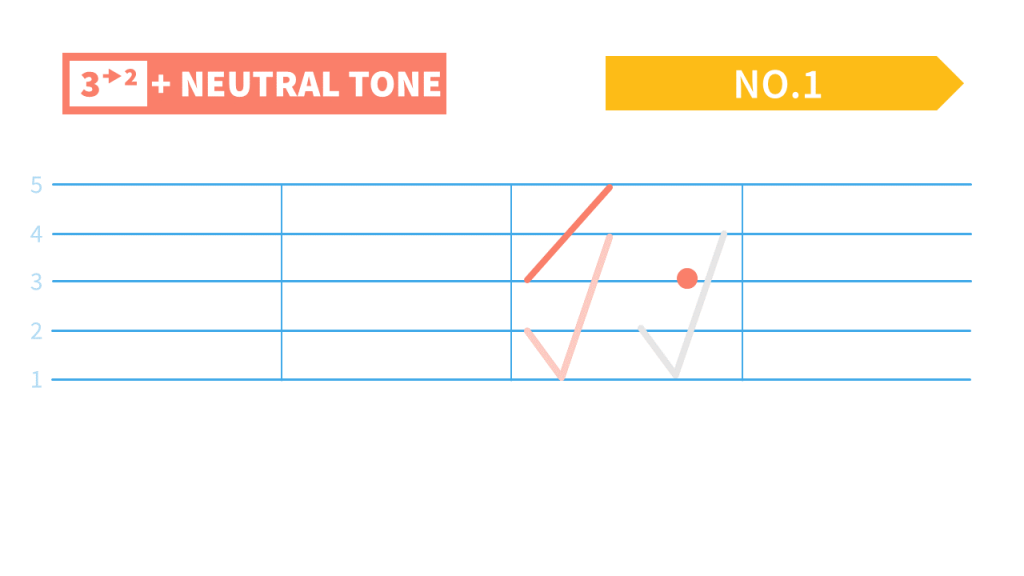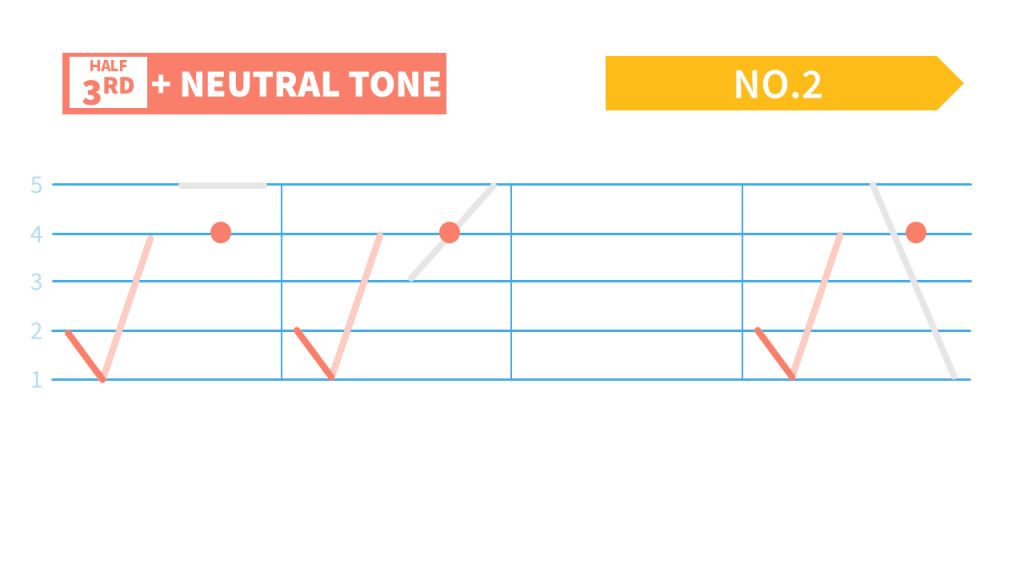Tone Lesson 12 – The Neutral Tone (2)

CHINESE NEUTRAL TONE: THIRD TONE + NEUTRAL TONE
Last time we practiced the Neutral Tone, and we already know that the Third Tone in front of the Neutral Tone is pronounce in the Half Third Tone. However, it is not always the case. The Third Tone in front of the Neutral Tone is sometimes pronounced in the Second Tone. In today's lesson, we'll discuss the Third Tone + the Neutral Tone and practice some Tone Pairs.
Three Ways to Pronounce The Third Tone
There are three ways in total to pronounce the Third Tone. As shown in the picture, (1) The original Full Third Tone (2) Third Tone becomes Second Tone (3) The Half Third Tone.

The Third Tone in Front of The Neutral Tone
Remember the Neutral-tone syllable already has an Original Tone that gets neutralized in certain situation? Its original Tone decides the pronunciation of the Third Tone in front of it. There are only two situations, as shown in the picture below. No.1 When the original Tone of the Neutral-tone syllable is the Third Tone, the Third Tone in front of it becomes the Second Tone; No.2 When the Neutral-tone syllable is originally in the First, the Second or the Fourth Tone, the Third Tone in front of it is pronounced in the Half Third Tone.


Tone Drills: The Third Tone + Neutral Tone
NO.1 Third Tone becomes Second Tone
Syllable-2 is originally in the Third Tone.
| PINYIN | 汉字 | TONE CHANGE |
|---|---|---|
| xiǎng xiang (xiǎng) | 想想 | xiáng xiang |
| děng deng (děng) | 等等 | déng deng |
| hǎo hao (hǎo) | 好好 | háo hao |
| jiǎng jiang (jiǎng) | 讲讲 | jiáng jiang |
NO.2 Third Tone becomes Half Third Tone
Syllable-2 is originally in the First, the Second or the Fourth Tone, which is marked in the parentheses "( )".
| PINYIN | 汉字 | TONE CHANGE |
|---|---|---|
| yǎn jing (jīng) | 眼睛 | yǎnhalf jing |
| lǎo po (pó) | 老婆 | lǎohalf po |
| dǎ suan (suàn) | 打算 | dǎhalf suan |
Neutral Tones in Sentences
All Neutral Tones are marked in red and underlined.
| 1 | ||
|---|---|---|
| bà ba mā ma mǎi dōng xi qù le | ||
| 爸爸妈妈买东西去了。 | ||
| (My) parents went shopping. |
| 2 | ||
|---|---|---|
| tā de jiě jie chuān zhe hóng qún zi | ||
| 她的姐姐穿着红裙子。 | ||
| Her big sister is wearing a red dress(skirt). |
| 3 | ||
| wǒ men dǎ suan hǎo hao xiǎng xiang | ||
| 我们打算好好想想。 | ||
| We plan to seriously think about it. |
Question: When we see a Pinyin syllable with no tone markings, is it always the Neutral Tone? Thank you.
If you cannot explain how to know the original tone of the neutral tone (as per your answer below 07/14/2018) then it makes this lesson very confusing. Perhaps it is better saved for more advance classes?
Sorry for the confusion. The original tone is learned with the character or vocabulary itself.
This lesson can be useful for both beginners and advanced students who want to improve their tones.
For beginners, the objective is to get a general idea of the tone system and start to imitate the pronunciations.
For advanced students, they can dive into the exceptions and more detailed principles and logic behind the tone changes.
I have a bit of a problem with the quiz. Various questions have neutral tone characters that sound like 4th tones. They are both quick, and they drop in pitch even though they are neutral. How would I distinguish between those two?
When determining what to do with the third tone in a third + neutral combination, how do I know what the original tone is, given that the neutral tone doesn’t provide any clues? Is it one of those things that comes with experience (i.e., listening to the correct pronunciation time and time again)? I think the sentence example at 4:56 in the video provides a good example. I can’t really decide what to do with the third tones in any of the words.
When you first see a new word, you either play the provided audio from your learning resource and copy that sound, or you look it up from an e-dictionary and play the audio from there.
Also, each character has an original tone, from learning that character you will know the original tone.
For beginners copying the audio would be enough. For more advanced learners, knowing each character’s original tone is something you acquire from the process of learning vocabulary and being exposed to Chinese materials.
According to this lesson, jiě jie should have the tone changed from third to second, yet in the previous lesson Lili definitely pronounces it with the 3rd tone. Why is that? Or am I misunderstanding something?..
姐姐 jiějie older sister and 奶奶 nǎinǎi grandma are examples of exceptions to this rule. There are other examples too. Generally examples like jiějie and nǎinai are words that already have a set pronunciation instead of temporarily putting together like the ones shown in “NO.1 Third Tone becomes Second Tone”. We decided to leave those exceptions out because the rules here are already complicated enough and to explain it clearly the grammar of Verb Complement and Reduplication of Verbs both need to be included(which are far from beginner level). Also since the pronunciations of the “exception examples” are set and do not change, they can be learned with the vocabulary.
Thank you for an extensive answer! Keep doing what you are doing!
Thank’s for the great answer on exceptions. I have been learning for a while now and wanted to learn more about these exceptions. I was thinking of going Premium, do you have lessons on the exceptions?